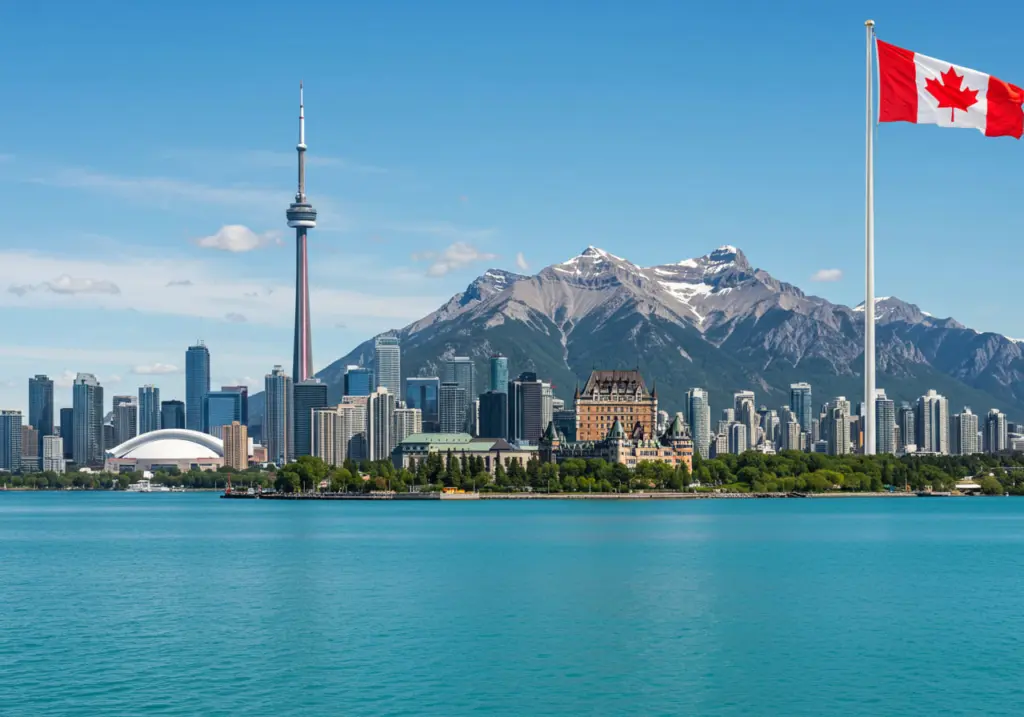How much salary is enough to live in Canada in 2025?
Determining how much salary you’ll need to live comfortably in Canada in 2025 hinges on understanding the cost of living. Dreaming of Canadian adventures? From stunning landscapes to vibrant cities, Canada offers a high standard of living, top-notch education, excellent healthcare, and a diverse cultural tapestry. But before you pack your poutine cravings, let’s talk money. Understanding the cost of living across Canada is crucial to ensure your salary fuels a comfortable life, not just survival.

How much Salary is enough to live comfortably in Canada in 2025?
Canada’s vast and diverse regions boast unique economic conditions and expenses. Major cities like Toronto, Vancouver, and Montreal will have significantly higher costs compared to smaller cities and rural areas.
Several essential factors determine how much you’ll need to live in Canada. These costs can vary widely based on the city or province you live in, the size of your household, and your lifestyle choices. Here’s a breakdown of the main elements:
Housing
Housing continues to be the largest single expense for most Canadians. According to the latest data from the Canada Mortgage and Housing Corporation (CMHC) in 2025:
- Toronto: The average monthly rent for a one-bedroom apartment is approximately CAD $2,500. For a two-bedroom, it’s about CAD $3,300.
- Vancouver: One-bedroom apartments average CAD $2,800, with two-bedrooms reaching CAD $3,500 or more.
- Halifax: A more affordable option, with one-bedroom units renting for around CAD $1,600, and two-bedrooms around CAD $2,000.
- Calgary & Winnipeg: Rent for a one-bedroom averages between CAD $1,450–$1,700.
Rent prices fluctuate depending on the neighborhood, building type, and proximity to downtown or transit lines. In general, renters should expect to spend 30% to 50% of their monthly income on housing alone in major cities.
Transportation
Your mode of transportation will significantly impact your budget:
- Public Transit: A monthly public transportation pass costs:
- Toronto (TTC): CAD $156
- Vancouver (TransLink): CAD $151 (Zone 1)
- Montreal (STM): CAD $97
- Calgary/Edmonton: CAD $112
Using public transit is cost-effective, especially if you live and work in urban centers.
- Car Ownership: Includes fuel, insurance, maintenance, licensing, and parking.
- Average total annual cost: CAD $9,800 – $10,500
- Gas prices in 2025 are averaging CAD $1.75/litre
- Insurance premiums vary by province but typically range from CAD $1,500 – $2,500 per year
Unless necessary, many newcomers opt to avoid car ownership in their first year due to high upfront and ongoing costs.
Healthcare
Canada has a publicly funded healthcare system, meaning most essential medical services are free at the point of care. However, there are some gaps:
- Dental care, prescriptions, vision care, and mental health services are not universally covered.
- On average, Canadian families spend around CAD $3,500 per year on out-of-pocket medical expenses.
- Many employers offer extended health insurance plans that cover additional services. Private insurance is also available for newcomers without provincial health coverage during their first few months.
Education
Education costs vary depending on the level (primary, secondary, or post-secondary) and whether the institution is public or private.
- Public schooling is free for children of permanent residents and many international workers.
- Post-secondary education (college/university) costs:
- Domestic students: CAD $6,800 – $8,000/year
- International students: CAD $20,000 – $35,000+/year, depending on the program and institution.
- Additional costs include school supplies, transportation, lunch programs, and occasional fees.
If you’re immigrating with children or planning to study, consider these costs in your budget.
Groceries
Grocery expenses vary based on location, diet, and preferences. According to Statistics Canada:
- A single adult can expect to spend CAD $350 – $500/month.
- A family of four typically spends CAD $1,200 – $1,600/month, especially if eating home-cooked meals regularly.
- Prices are higher in northern communities or remote areas due to transportation costs.
Frequent shopping at discount grocery chains like No Frills, Superstore, or Costco can help save money.
Entertainment
Leisure and entertainment are important for quality of life but can impact your budget:
- Average monthly spending on entertainment is about CAD $250, which includes:
- Dining out
- Movie tickets
- Streaming services
- Occasional concerts or sports events
- Free or low-cost options such as public parks, cultural festivals, and community activities are widely available and can help reduce costs.
Budgeting for leisure is important to maintain balance and mental health, especially when adjusting to a new country.
Find out if you are eligible to get in Canada →
What is a good salary for a single person in Canada in 2025?
Defining “Good” and the Inflationary Bite: A Single Person’s Salary in Canada (2025)
Pinpointing a single “good” salary for a single person in Canada for 2025 is tricky. Why? Because “good” is subjective and hinges on your lifestyle and desired location. Here’s what we can do:
1. Understanding the Impact of Inflation in 2025
In 2025, inflation in Canada is projected to stabilize around 2.5%, after several years of higher-than-average rates. While this is a welcome relief for many, the cumulative effect of previous years’ inflation still affects prices across key sectors such as housing, groceries, utilities, and transportation.
Due to these persistent cost pressures, what constituted a “comfortable” salary in 2020 or 2021 may no longer be sufficient. If you earned CAD 48,000–50,000 in past years and managed well, you might now need at least CAD 55,000–60,000 just to maintain that same standard of living in 2025.
2. How Geography Drastically Affects Salary Expectations
Canada is a geographically vast and economically diverse country. Living costs can vary significantly depending on the city or province you choose to reside in:
- Major Urban Centers (Toronto, Vancouver, Ottawa, Calgary):
These cities have significantly higher costs of living, especially in terms of rent and transportation. A comfortable single-person salary in Toronto or Vancouver in 2025 is estimated at CAD 65,000 to 75,000 per year. - Mid-Sized Cities (Halifax, Winnipeg, Saskatoon):
These cities offer a more balanced cost-of-living-to-salary ratio. A single person may live comfortably on a salary between CAD 50,000 and 60,000 per year. - Smaller Towns and Rural Areas:
With significantly lower rental and transportation costs, a salary of around CAD 45,000 to 50,000 can suffice for a modest yet comfortable lifestyle.
Keep in mind that while smaller cities offer cost savings, job opportunities in certain industries may be more limited, and salaries may also be slightly lower.
3. Lifestyle Choices Matter More Than You Think
Beyond geography, your personal spending habits are critical in defining what “comfortable” means for you. Some examples:
If you’re planning to save or invest—for a house, emergency fund, or future family needs—you’ll need to budget at least 10%–20% of your net income toward savings. That may push your “comfortable” salary range upward by another CAD 5,000–10,000 annually.
If you’re socially active—frequent restaurants, bars, concerts, and travel—you’ll need a higher disposable income. In this case, your target salary should lean toward CAD 70,000 or more, especially in a major city.
If you’re budget-conscious, preparing meals at home, relying on public transit, and enjoying low-cost leisure (like hiking or community events), a salary of CAD 55,000 in an urban area—or even CAD 45,000 in smaller cities—might provide you with a very stable life.
4. Breakdown of Estimated Comfortable Salary in 2025
To put all the factors into a clear frame of reference, here are updated salary benchmarks for 2025:
| Household Type | Estimated Comfortable Annual Salary (2025) |
|---|---|
| Single Person (Urban) | CAD 60,000 – 75,000 |
| Single Person (Small City/Town) | CAD 45,000 – 55,000 |
| Couple (Combined Income) | CAD 80,000 – 100,000 |
| Family of Four | CAD 120,000 – 140,000 |
These figures consider modest discretionary spending, some travel, and savings goals. Of course, your actual experience will depend on your own choices.
Tools to help you Estimate Your Ideal Salary
If you’re unsure where you stand or where you’re headed, consider using online cost-of-living calculators:
- Numbeo – lets you compare cities side by side
- Moving2Canada Cost of Living Calculator
- Wowa.ca Budget Planner
These tools can factor in your chosen city, housing preferences, transportation method, and even grocery habits to estimate a more accurate salary range.
5. Beyond the Paycheck: Other Factors That Define “Comfort”
A good salary is just one part of living comfortably. You also need to manage your money wisely and plan for the future. Here are some strategies:
Think Long-Term: Saving for a home, building an emergency fund, or investing in your skills through education are all important for long-term financial well-being.
Build and Stick to a Budget: Use tools like YNAB (You Need A Budget) or Mint to track your spending and savings goals.
Limit Debt: High-interest credit card debt or car loans can quickly erode your income, no matter how high it is. Prioritize paying off debts or avoiding them altogether.
Cut Costs Where You Can:
- Cook at home more often than eating out.
- Take advantage of public transportation and free community events.
- Look for roommates or shared accommodation when starting out.
Maximize Employer Benefits: If your employer offers benefits like extended healthcare, dental, RRSP matching, or professional development budgets, these add significant value to your total compensation.
Find out if you are eligible to get in Canada
How much does a couple need to live in Canada (2025)?
Canada’s breathtaking scenery, multicultural cities, and strong quality of life continue to attract couples looking to start a life together. But building a future—whether you’re newlyweds or long-time partners—starts with understanding the financial realities of living in the Great White North.
The Inflation Reality in 2025
Let’s get this out of the way—inflation continues to influence household budgets across the country. While Canada’s inflation rate is projected to stabilize around 2.5% in 2025, the residual effects of high inflation from recent years are still felt. Prices for housing, groceries, utilities, and transportation remain elevated compared to pre-2020 levels.
That means couples today need a higher combined income than in previous years just to maintain the same standard of living. This makes budgeting, cost-sharing, and financial planning more important than ever.
Average Monthly Living Costs for Couples in 2025
Based on current trends and 2025 estimates, couples in Canada should expect to spend anywhere from CAD $3,800 to $5,500 per month, depending on location and lifestyle. Here’s a rough breakdown of typical monthly expenses for two people living together:
| Expense Category | Average Monthly Cost (CAD) |
|---|---|
| Rent (1-bedroom) | $1,800 – $2,800 |
| Utilities & Internet | $200 – $350 |
| Groceries | $800 – $1,200 |
| Transportation | $300 – $600 |
| Health Insurance / Out-of-Pocket | $250 – $400 |
| Entertainment & Dining | $300 – $500 |
| Miscellaneous (clothes, toiletries, etc.) | $150 – $250 |
➡️ Estimated Monthly Total: CAD $3,800 – $5,500
➡️ Estimated Annual Total: CAD $45,600 – $66,000
Keep in mind, these numbers can vary dramatically depending on whether you live in urban centers or smaller towns, and how you choose to spend.
Urban vs. Rural: The Location Effect
City Life (Toronto, Vancouver, Montreal):
Living in a major urban center means you’ll have access to more job opportunities, entertainment, public transit, and cultural events. But it comes at a cost—rent in downtown Toronto or Vancouver can easily exceed CAD $2,500/month for a modest one-bedroom apartment. Dining out, transit passes, and general expenses are also significantly higher.
Small Cities & Towns (Kelowna, Moncton, Saskatoon):
In smaller communities, couples can often live more comfortably on less. Rent can drop to CAD $1,200 – $1,600/month, and the pace of life is typically slower. However, you may need to own a car (adding insurance and fuel expenses), and job opportunities may be more limited depending on your industry.
The Power of Shared Expenses
One of the biggest advantages of living as a couple is the ability to share the financial load. While costs like groceries and rent don’t necessarily double for two people, they do scale—often making life more affordable per person compared to living solo.
For example:
- A couple renting a $2,000 apartment splits that into $1,000 each.
- Meal planning and buying groceries in bulk becomes more efficient.
- Utility bills increase slightly, but not double.
- Shared transportation (owning one car instead of two) can also save money.
Lifestyle Matters: How You Live Affects What You Need
Your monthly budget will also vary depending on your values and lifestyle choices. For example:
- Active Social Life: If you’re both into concerts, dining out, weekend trips, and live events, your entertainment and travel budgets will grow accordingly.
- Frugal & Minimalist: If you’re content with cooking at home, streaming services instead of movie nights out, and using public transportation, your cost of living can be substantially lower.
- Health-Conscious or Special Diets: Couples with dietary restrictions, wellness plans, or special health needs may spend more on groceries, supplements, or private health care.
Income Ranges: What Should Couples Earn in 2025?
Let’s translate all of this into practical income expectations for couples living in Canada in 2025.
| Living Standard | Estimated Combined Annual Income (CAD) | Description |
|---|---|---|
| Bare Minimum / Survival | $30,000 – $35,000 | Minimal rent, low-cost groceries, likely living in rural area or with roommates. No savings. |
| Moderate / Basic Comfort | $50,000 – $60,000 | Rent in affordable city, occasional dining out, some savings. May still require budgeting. |
| Comfortable Living | $70,000 – $85,000 | Private apartment in mid-size city, ability to save, enjoy regular entertainment and travel. |
| Urban, Upscale Lifestyle | $90,000 – $110,000+ | Living in major city with higher-end spending, greater financial flexibility, and long-term planning. |
This takes into account inflation, housing, and the rising cost of living in Canada.
Budgeting Tools & Planning Resources
To help plan your finances as a couple, consider using the following resources:
- Government Benefits Calculators: Check for family tax credits, rent assistance, or health subsidies.
- Numbeo: Compare cost of living between cities.
- Wowa Cost of Living Calculator: Estimate monthly budgets based on lifestyle and location.
- Mint or YNAB: Tools to track joint spending, savings, and financial goals.
For more Canadian visa inquiries? Click here to start the process with our help →
How Much Money Does a Family of 4 Need to Live in Canada in 2025?
Canada continues to be one of the most attractive countries in the world for families. With its strong healthcare system, clean environment, good education, and family-friendly policies, many people see Canada as the ideal place to raise children. However, behind the idyllic lifestyle lies the pressing question in 2025: How much does it really cost for a family of four to live comfortably in Canada today?
Inflation and the Rising Cost of Living
Inflation has gradually eased to an estimated 2.5% in 2025, but that doesn’t mean costs have gone down—only that they’re not rising as quickly. Prices for food, housing, transportation, and childcare remain significantly higher than they were just a few years ago.
To maintain a stable and comfortable standard of living, your household income must reflect these increases. While the exact figure can vary based on region, family needs, and lifestyle choices, we can break things down into more specific cost brackets.
Key Family Expenses to Consider
Several major cost areas can influence how much your family will need in 2025:
| Expense Category | Estimated Monthly Cost (CAD) | Notes |
|---|---|---|
| Housing (Rent or Mortgage) | $2,500 – $3,500 | Depends on city; higher in Toronto, Vancouver |
| Utilities & Internet | $300 – $500 | Heating can be a major cost in winter months |
| Groceries & Household Items | $1,200 – $1,600 | Varies by dietary needs, family habits |
| Transportation | $500 – $900 | Includes car payments, insurance, gas/public transit |
| Childcare / School Fees | $1,000 – $2,000 | Higher in major cities; may vary based on child’s age |
| Healthcare (not fully covered) | $200 – $400 | Out-of-pocket expenses and supplemental insurance |
| Entertainment, Clothing, Activities | $400 – $800 | Includes dining out, kids’ activities, seasonal gear |
| Emergency / Savings / Miscellaneous | $300 – $600 | Buffer for unexpected costs |
➡️ Estimated Monthly Total: $6,400 – $9,300
➡️ Estimated Annual Total: $76,800 – $111,600 (pre-tax)
Family Needs and Lifestyle Considerations
The composition and age of your children significantly affect your budget:
- Young Children (0–5 years): Daycare or full-time childcare can cost $900–$1,800 per child per month, especially in larger cities. Fortunately, some provinces now offer subsidized daycare programs that can help reduce these expenses.
- School-age Children (6–12 years): Public schooling is free, but there are still costs for school supplies, clothing, field trips, and lunches.
- Teenagers (13–18 years): Costs can rise due to increased needs for technology (phones, laptops), extracurricular activities (sports, music), transportation, and clothing.
Lifestyle Choices: Necessity vs. Comfort
Your desired lifestyle dramatically affects your required income:
- Frugal Family Living:
A family of four living in a smaller town with modest needs (basic rent, home-cooked meals, limited outings) might manage with a combined pre-tax income of around $80,000 per year. This budget covers the essentials, but may not include full childcare coverage or significant savings. - Comfortable Urban Living:
In urban centers or with more spending flexibility (e.g., weekend getaways, family events, hobbies), a family should aim for a minimum pre-tax income of $95,000 to $110,000. This allows for childcare, savings, healthcare extras, and a balanced lifestyle. - Affluent or Flexible Lifestyle:
If you’re aiming for a lifestyle with frequent travel, private schooling, or investment goals, your family may need a household income of $130,000 or more.
Regional Variations in Cost of Living
- Toronto/Vancouver: These cities remain the most expensive, with housing and childcare being the highest contributors to overall costs.
- Calgary/Edmonton: More affordable housing, especially for families who own property.
- Halifax/Winnipeg/Regina: Often offer a lower cost of living, but may have fewer job opportunities in certain sectors.
- Suburban or Rural Areas: Significantly lower rent and living expenses, but transportation costs may increase due to lack of public transit options.
Summary Table: Family of Four Annual Income Guidelines (2025)
| Lifestyle Type | Pre-Tax Annual Income Needed | Description |
|---|---|---|
| Basic Needs Only | $80,000 – $85,000 | Covers essentials only, limited savings, possibly subsidized daycare |
| Comfortable Lifestyle | $95,000 – $110,000 | Most Canadian families fall here; allows for savings, childcare, modest outings |
| Affluent/Urban Luxury | $130,000+ | For private schools, extensive travel, upscale housing |
Raising a family in Canada in 2025 is still a rewarding experience, but it requires realistic financial planning. Here are some final tips:
- Plan for Emergencies: Have at least 3–6 months of living expenses saved.
- Use Government Support: Programs like the Canada Child Benefit (CCB) can help offset child-rearing costs.
- Optimize Tax Benefits: Leverage child care deductions, RESP savings, and family tax credits.
- Budget Wisely: Review spending monthly and adjust based on changing needs.
By understanding your family’s priorities and financial obligations, you’ll be better equipped to build a secure, fulfilling life in Canada.
Can You Survive on $3,500 a Month in Canada (2025)?
Living comfortably on CAD 3,500 per month in Canada in 2025 depends heavily on your location and lifestyle choices. Here’s a breakdown to consider inflation’s impact:
Please, note that these figures are estimated and can vary significantly depending on individual circumstances.
City Living vs. Small-Town Charm
Big cities like Toronto, Vancouver, and Montreal offer exciting experiences, but they come with a price tag. Rent can gobble up a significant portion of your $3,500, leaving less for groceries, transportation, and entertainment. Opting for a smaller town or rural area can significantly reduce your housing costs. With $3,500, you might have more room for necessities and even some leisure activities.
Your spending habits also play a big role. If you’re a budgeting pro who cooks at home, uses public transportation, and enjoys free entertainment, $3,500 could cover your basic needs in most areas. However, if you enjoy socializing at restaurants, attending events, or need a larger living space, $3,500 might feel tight, especially in major cities.
In some situations, with careful budgeting and a frugal lifestyle, $3,500 could be enough to survive in Canada, especially in smaller towns. However, for a truly comfortable standard of living with room for extras, aiming for a closer to $40,000 per year salary (roughly $3,333 per month) might be more realistic, especially considering inflation.
Canada is a beautiful place to live, but the cost of living can be daunting. Planning and understanding your personal needs is key to a comfortable life. Remember, planning and understanding your personal needs is the key to a comfortable life in Canada.
So, don’t let the numbers discourage you! Utilize the insights and resources in this blog to create a personalized roadmap for your Canadian Dream. Dive into online cost-of-living calculators, explore budgeting strategies, and consider your desired lifestyle.











